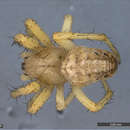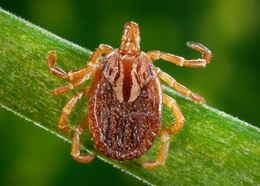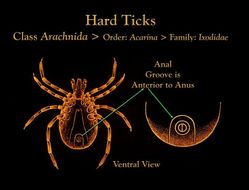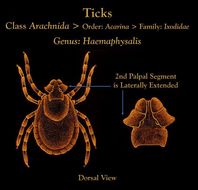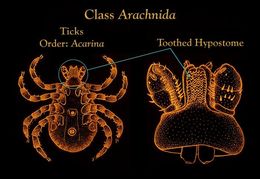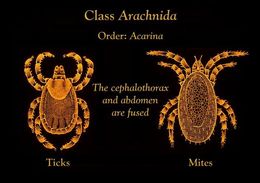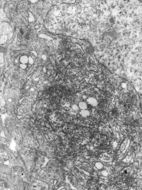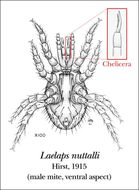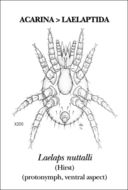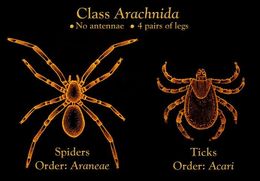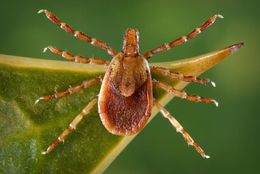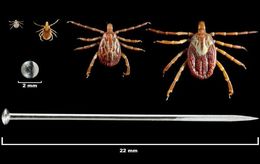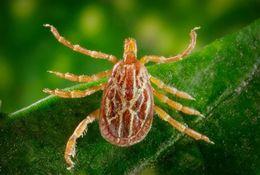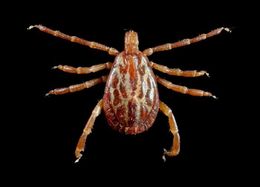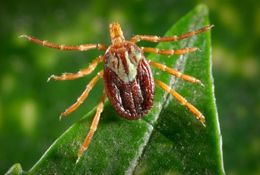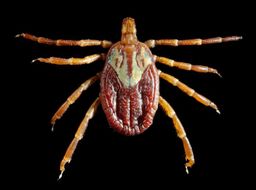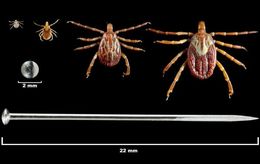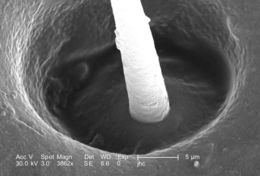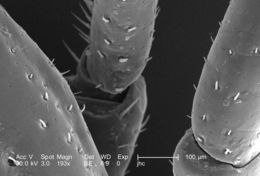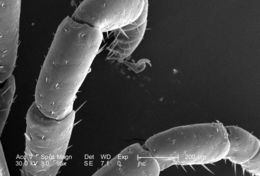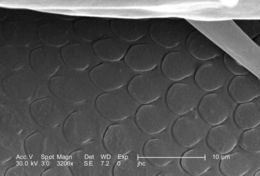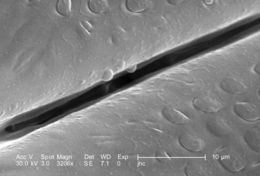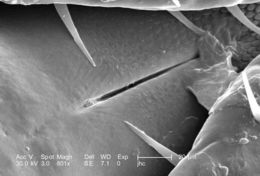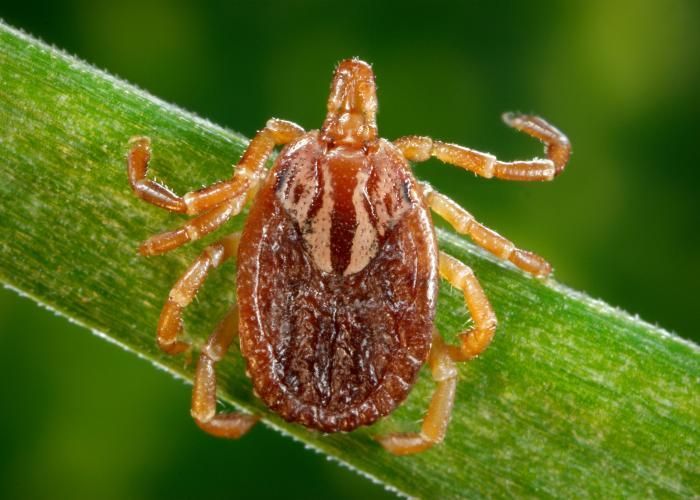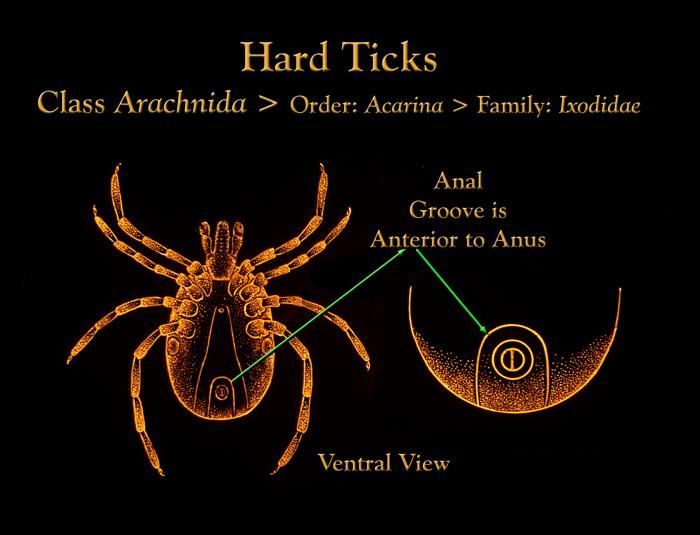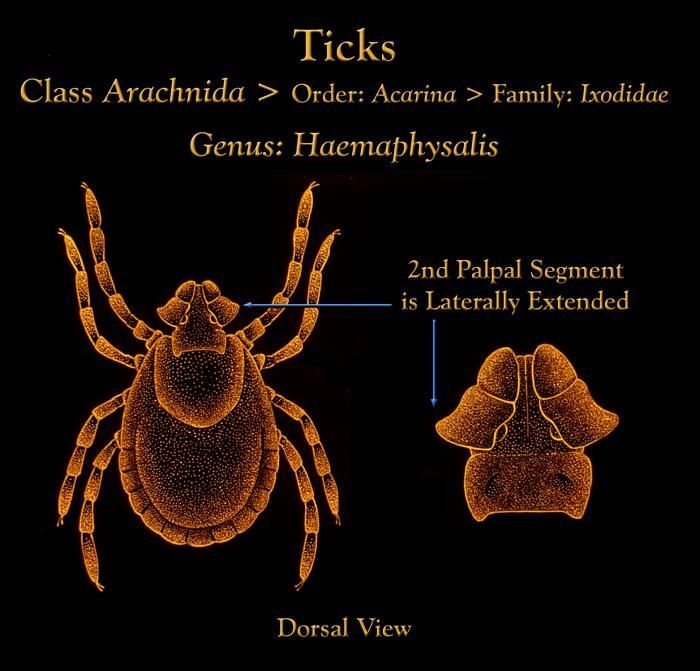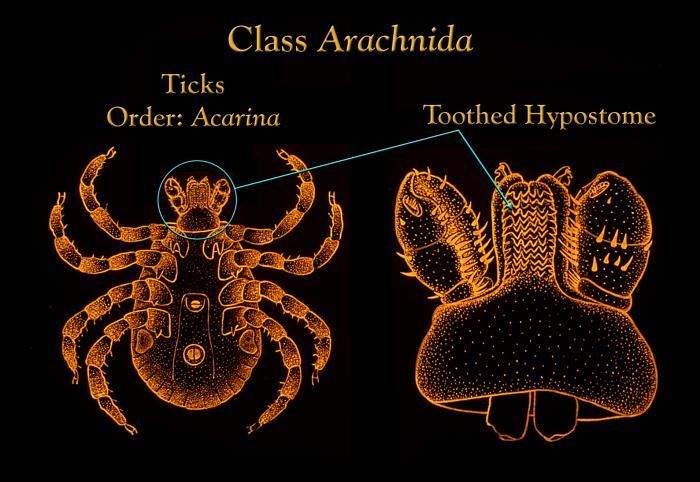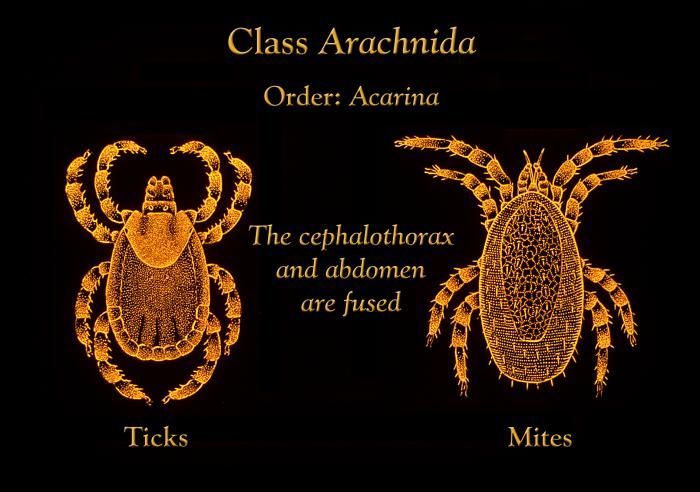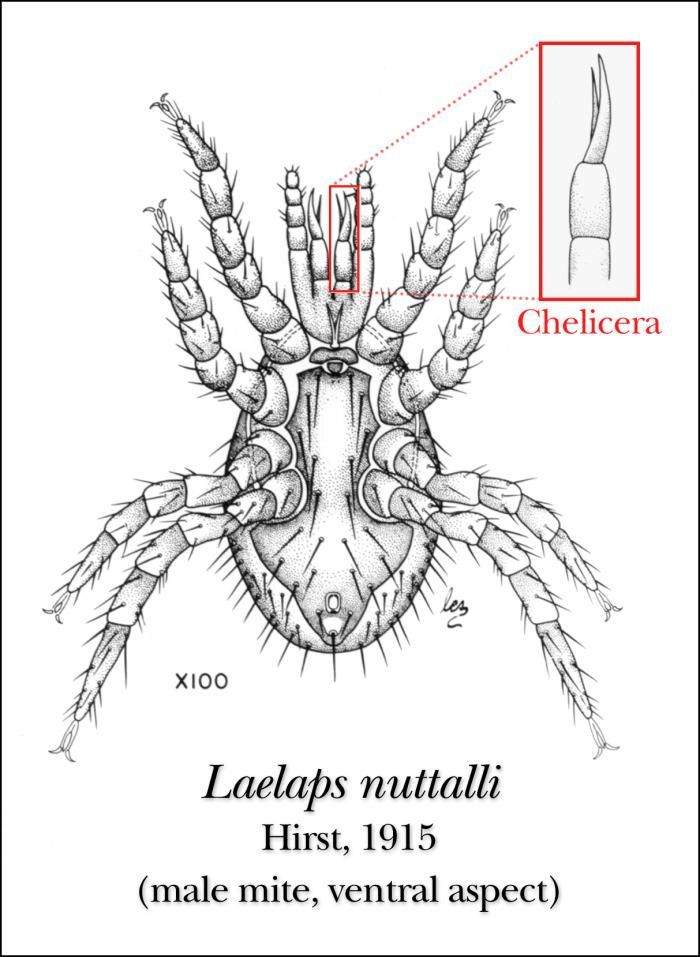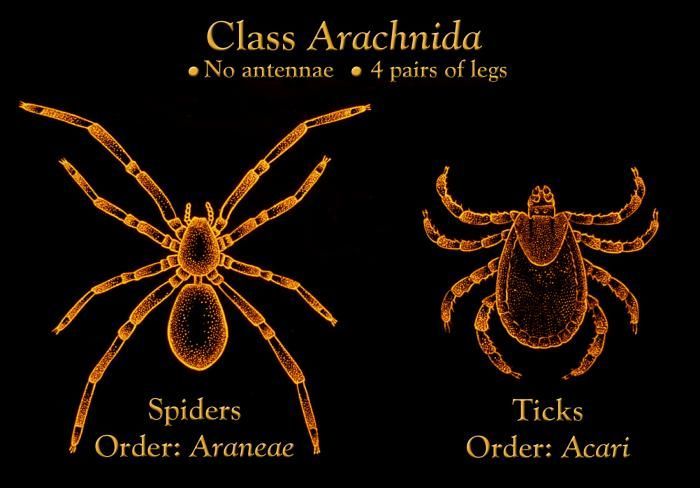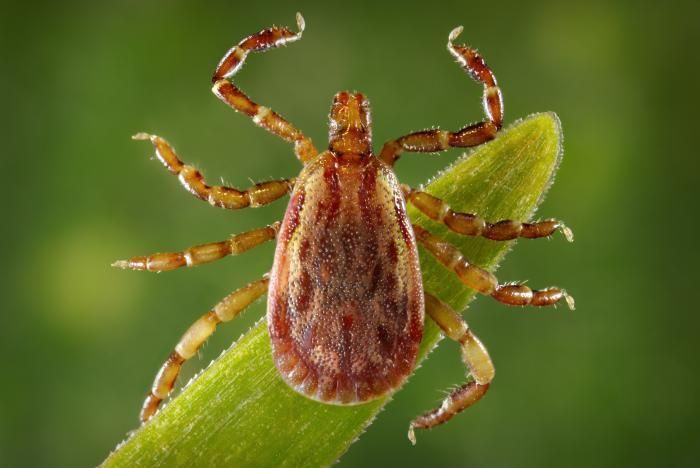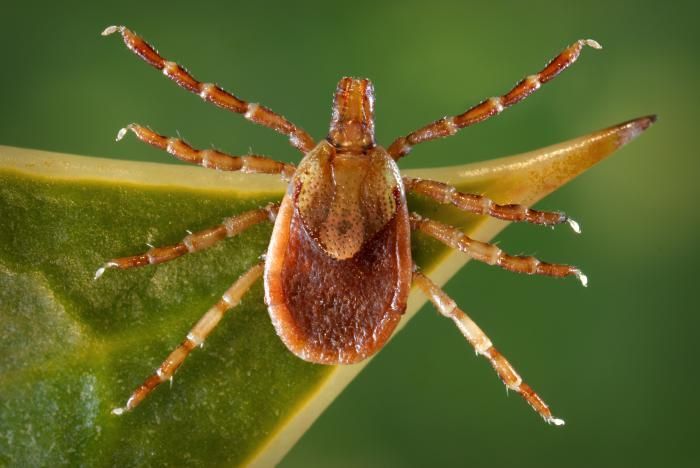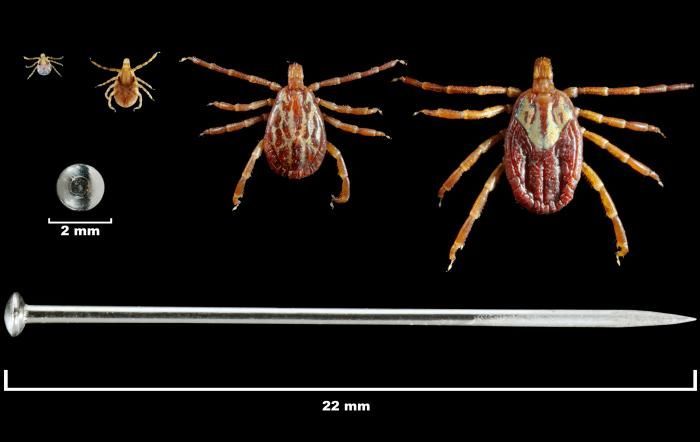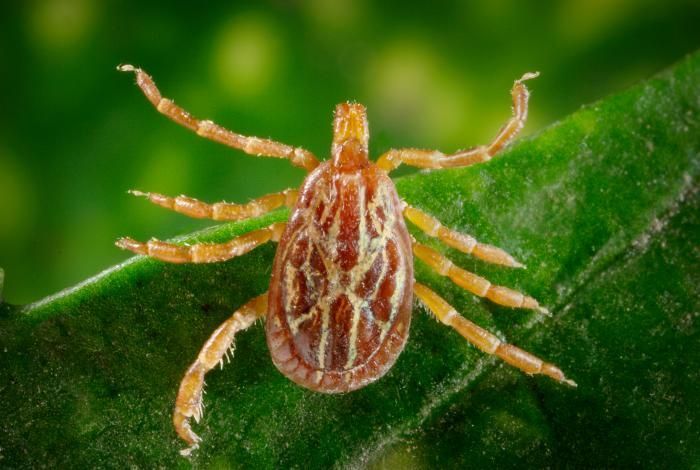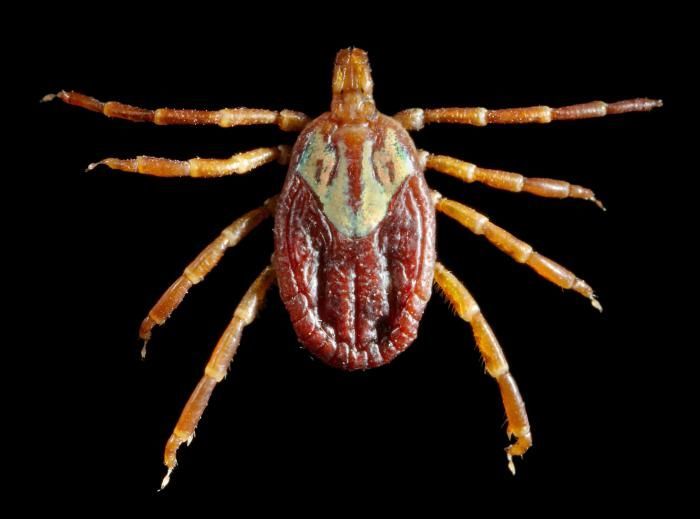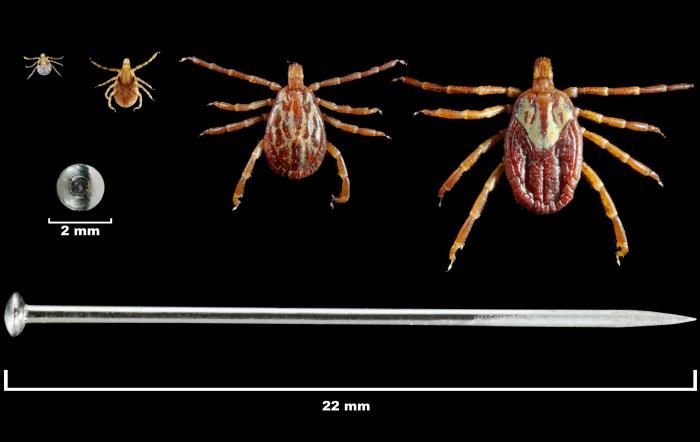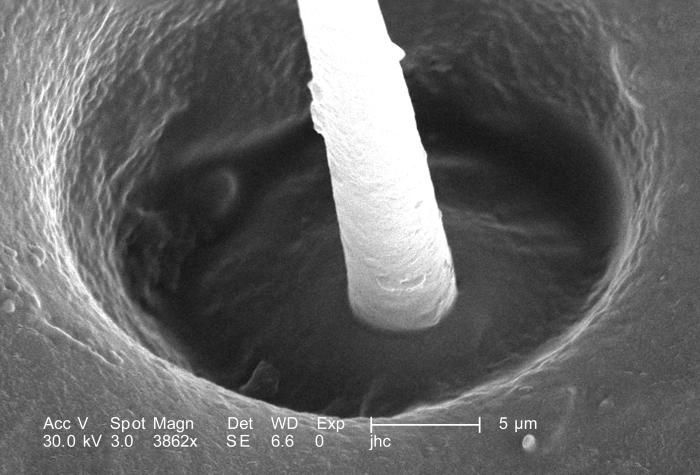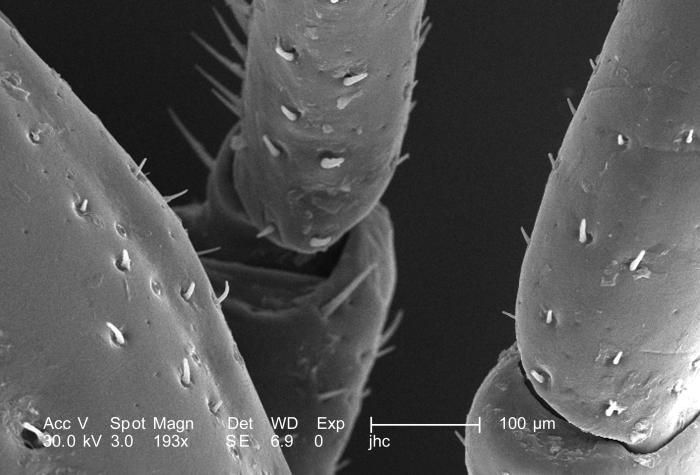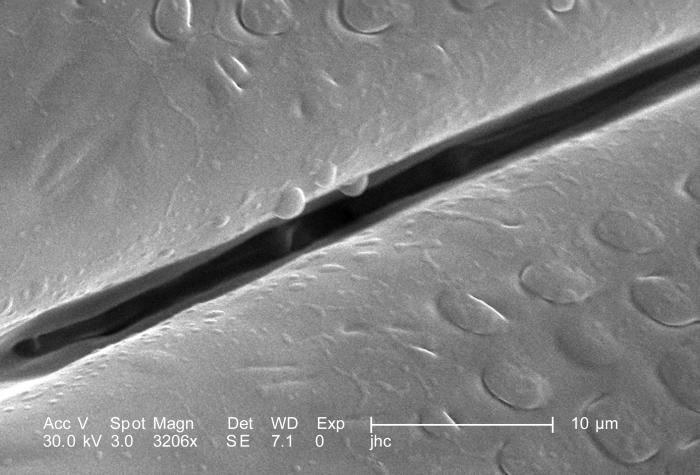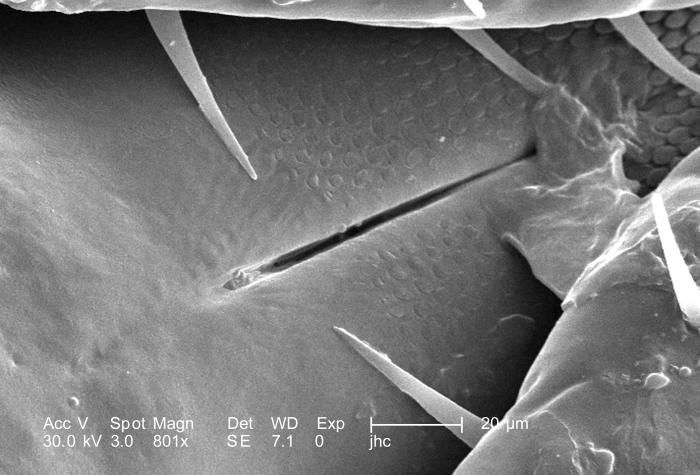-
This 2008 photograph depicted a female, Amblyomma triste from a dorsal view, as it was climbing a blade of grass.With its eight jointed legs, like its tick bretheren, this animal is a member of the phylum Arthropoda, and the like scorpions and spiders, the class Arachnida. Though a 2004 study in Uruguay showed A. triste to be a carrier of Rickettsia parkeri, and it is known that these arthropods do feed upon human hosts, it was not definitively determined that human rickettsioses were the result of this ticks bite (see the link below).Created: 2008
-
Members of the genus Ixodes are easily distinguished by their conspicuous anal groove, which is anterior to the anus.Created: 1976
-
This drawing depicts the mouthparts displayed by members of the hard ticks in the genus Haemaphysalis.Created: 1976
-
This illustration depicts the morphologic features of a tick from the Order Acarina focusing on the hypostome mouth part.Created: 1976
-
This illustration depicts the anatomic features found in both ticks and mites, each group belonging to the order Acarina.Created: 1976
-
This 1975 transmission electron micrograph (TEM) revealed the presence of Russian spring-summer encephalitis (RSSE) virus virions in this tissue sample. As a tick-borne encephalitis, RSSE is an arbovirus, which means that its transmitted through the bite of an infected Ixodes persulcatus tick.Created: 1975
-
This illustration reveals the morphologic characteristics on the ventral surface of the male mite Laelaps nuttalli.Created: 1975
-
This illustration reveals the morphologic features on the ventral surface of the protonymph staged mite, Laelaps nuttalli.Created: 1975
-
This image shows the anatomic differences between the two arachnid Orders of spiders, Araneae, and ticks, Acari.Created: 1976
-
This 2008 photograph depicts a dorsal view of a male yellow dog tick, Amblyomma aureolatum, which is a vector of Rocky Mountain spotted fever (RMSF) in the country of Brazil.Note that the back of this tick is completely covered by his hard, scutum, or shield. However, when this feature is compared with that of the female counterpart of this Ixodidae hard tick, PHIL 11069, youll note that the females dorsal abdomen is only partially covered, which allows her abdomen to greatly expand when she is ingesting her blood meal.Created: 2008
-
This 2008 photograph depicts a dorsal view of a female yellow dog tick, Amblyomma aureolatum, which is a vector of Rocky Mountain spotted fever (RMSF) in the country of Brazil.Note that the back of this tick is only partially covered by her hard, scutum, or shield, which allows her abdomen to expand to many times the size seen here. Compare this feature with that of the male counterpart of this Ixodidae hard tick, PHIL 11070, and observe how the male's scutum covers his entire dorsal abdomen.Created: 2008
-
Using a pin as a reference tool, this photograph depicts a dorsal view of four Amblyomma maculatum ticks. From left to right, this group of four included a larval tick, a nymph, an adult male, and at far right, an adult female. Note that the head of the pin measures just under 2mm in diameter, while its full length measures 22mm.This tick specie is a known vector for Rickettsial organisms, Rickettsia parkeri, and Ehrlichia ruminantium, formerly Cowdria ruminantium. R. parkeri is a member of the spotted fever group of rickettsial diseases affecting humans, while E. ruminantium causes heartwater disease, an infectious, noncontagious, tick-borne disease of domestic and wild ruminants, including cattle, sheep, goats, antelope, and buffalo. Each life stage depicted here, can feed on human hosts, and can be infected with Rickettsia parkeri.Created: 2008
-
This photograph depicts a dorsal view of a male Gulf Coast tick, Amblyomma maculatum.This tick specie is a known vector for Rickettsial organisms, Rickettsia parkeri, and Ehrlichia ruminantium, formerly Cowdria ruminantium. R. parkeri is a member of the spotted fever group of rickettsial diseases affecting humans, while E. ruminantium causes heartwater disease, an infectious, noncontagious, tick-borne disease of domestic and wild ruminants, including cattle, sheep, goats, antelope, and buffalo.Created: 2008
-
This photograph depicts a dorsal view of a male Gulf Coast tick, Amblyomma maculatum.This tick specie is a known vector for Rickettsial organisms, Rickettsia parkeri, and Ehrlichia ruminantium, formerly Cowdria ruminantium. R. parkeri is a member of the spotted fever group of rickettsial diseases affecting humans, while E. ruminantium causes heartwater disease, an infectious, noncontagious, tick-borne disease of domestic and wild ruminants, including cattle, sheep, goats, antelope, and buffalo.Created: 2008
-
This photograph depicts a dorsal view of a female Gulf Coast tick, Amblyomma maculatum.This tick specie is a known vector for Rickettsial organisms, Rickettsia parkeri, and Ehrlichia ruminantium, formerly Cowdria ruminantium. R. parkeri is a member of the spotted fever group of rickettsial diseases affecting humans, while E. ruminantium causes heartwater disease, an infectious, noncontagious, tick-borne disease of domestic and wild ruminants, including cattle, sheep, goats, antelope, and buffalo.Created: 2008
-
This photograph depicts a dorsal view of a female Gulf Coast tick, Amblyomma maculatum.This tick specie is a known vector for Rickettsial organisms, Rickettsia parkeri, and Ehrlichia ruminantium, formerly Cowdria ruminantium. R. parkeri is a member of the spotted fever group of rickettsial diseases affecting humans, while E. ruminantium causes heartwater disease, an infectious, noncontagious, tick-borne disease of domestic and wild ruminants, including cattle, sheep, goats, antelope, and buffalo.Created: 2008
-
Using a pin as a reference tool, this photograph depicts a dorsal view of four Amblyomma maculatum ticks. From left to right, this group of four included a larval tick, a nymph, an adult male, and at far right, an adult female. Note that the head of the pin measures just under 2mm in diameter, while its full length measures 22mm.This tick specie is a known vector for Rickettsial organisms, Rickettsia parkeri, and Ehrlichia ruminantium, formerly Cowdria ruminantium. R. parkeri is a member of the spotted fever group of rickettsial diseases affecting humans, while E. ruminantium causes heartwater disease, an infectious, noncontagious, tick-borne disease of domestic and wild ruminants, including cattle, sheep, goats, antelope, and buffalo. Each life stage depicted here, can feed on human hosts, and can be infected with Rickettsia parkeri.Created: 2008
-
Under a high magnification of 3862X, this scanning electron micrograph (SEM) depicted the recessed base of a singe seta, or hair emanating from the dorsum of an unidentified male Dermacentor sp. tick found upon a cat in the suburbs of Decatur, Georgia, which measured approximately 3.5mm from its gnathosoma (i.e., capitulum), which is where its mouthparts are located, to the distal abdominal margin (PHIL 9961). PHIL 9959 revealed all this ticks legs, placing it into the Phylum Arthropoda, i.e., from jointed ( Arthro), and legs (poda), as well as the Class Arachnida, for theyve eight of these legs, unlike insects, which use six appendages to move about. Setae are chitinous exoskeletal adnexae which are sensorial in nature, sensing environmental changes in temperature, movement, i.e., wind, and chemistry, i.e., pheromones.Created: 2006
-
Under a relatively low magnification of 98X, this scanning electron micrograph (SEM) provided a closer view of this male Dermacentor sp. tick found upon a cat in the suburbs of Decatur, Georgia, which measured approximately 3.5mm from its gnathosoma (i.e., capitulum), which is where its mouthparts are located, to the distal abdominal margin (PHIL 9961). PHIL 9959 revealed all this ticks legs, placing it into the Phylum Arthropoda, i.e., from jointed ( Arthro), and legs (poda), as well as the Class Arachnida, for theyve eight of these legs, unlike insects, which use six appendages to move about. From proximal to distal location, each leg is comprised of a coxa, trochanter 1, trochanter 2, a femur, patella, tibia, a two-sectioned tarsus, and a two-part pretarsus, i.e., a pulvillus and claw. Here we see the trochantofemoral joints of the arachnids left 3rd and 4th legs, and the femoropatellar joints of its left 2nd and 3rd legs.Created: 2006
-
Under a relatively low magnification of 193X, this scanning electron micrograph (SEM) provided a closer view of this male Dermacentor sp. tick found upon a cat in the suburbs of Decatur, Georgia, which measured approximately 3.5mm from its gnathosoma (i.e., capitulum), which is where its mouthparts are located, to the distal abdominal margin (PHIL 9961). PHIL 9959 revealed all this ticks legs, placing it into the Phylum Arthropoda, i.e., from jointed ( Arthro), and legs (poda), as well as the Class Arachnida, for theyve eight of these legs, unlike insects, which use six appendages to move about. From proximal to distal location, each leg is comprised of a coxa, trochanter 1, trochanter 2, a femur, patella, tibia, a two-sectioned tarsus, and a two-part pretarsus, i.e., a pulvillus and claw. Here we see the trochantofemoral joint of the arachnids left 3rd leg, and the femoropatellar joint of its left 2nd leg.Created: 2006
-
Under a relatively low magnification of 95X, this scanning electron micrograph (SEM) provided a closer view of this male Dermacentor sp. tick found upon a cat in the suburbs of Decatur, Georgia, which measured approximately 3.5mm from its gnathosoma (i.e., capitulum), which is where its mouthparts are located, to the distal abdominal margin (PHIL 9961). PHIL 9959 revealed all this ticks legs, placing it into the Phylum Arthropoda, i.e., from jointed ( Arthro), and legs (poda), as well as the Class Arachnida, for theyve eight of these legs, unlike insects, which use six appendages to move about. From proximal to distal location, each leg is comprised of a coxa, trochanter 1, trochanter 2, a femur, patella, tibia, a two-sectioned tarsus, and a two-part pretarsus, i.e., a pulvillus and claw. Here we see the femur, patella, and tibia of arachnids left 2nd and 3rd legs.Created: 2006
-
Under a magnification of 3206X, four times greater than PHIL 9965, this scanning electron micrograph (SEM) depicted a dorsal view of an unidentified male Dermacentor sp. tick found upon a cat in the suburbs of Decatur, Georgia, which measured approximately 3.5mm from its gnathosoma (i.e., capitulum), which is where its mouthparts are located, to the distal abdominal margin (PHIL 9961). Note in PHIL 9959 and 9960, that the entire dorsum of this ticks abdomen is covered by its tough scutum, or shield, categorizing it as a male. In female Ixodid-species ticks, the scutum only partially covers the dorsal abdomen. Revealed in this image is the base of the hypostome, which is one of the ticks mouthparts that acts to pierce the host skin surface, thereby, anchoring the tick to the host as it obtains its blood meal. See PHIL 9964 for another view of the foliated hypostomal surface, which begins here as small scales.Created: 2006
-
Under a magnification of 3206X, four times greater than PHIL 9965, this scanning electron micrograph (SEM) depicted a dorsal view of an unidentified male Dermacentor sp. tick found upon a cat in the suburbs of Decatur, Georgia, which measured approximately 3.5mm from its gnathosoma (seen here) (i.e., capitulum), which is where its mouthparts are located, to the distal abdominal margin (PHIL 9961). Note in PHIL 9959 and 9960, that the entire dorsum of this ticks abdomen is covered by its tough scutum, or shield, categorizing it as a male. In female Ixodid-species ticks, the scutum only partially covers the dorsal abdomen. Revealed in this image is the base of the hypostome, which is one of the ticks mouthparts that acts to pierce the host skin surface, thereby, anchoring the tick to the host as it obtains its blood meal. See PHIL 9964 for another view of the foliated hypostomal surface.Created: 2006
-
Under a magnification of 801X, this scanning electron micrograph (SEM) depicted a dorsal view of an unidentified male Dermacentor sp. tick found upon a cat in the suburbs of Decatur, Georgia, which measured approximately 3.5mm from its gnathosoma (seen here) (i.e., capitulum), which is where its mouthparts are located, to the distal abdominal margin (PHIL 9961). Note in PHIL 9959 and 9960, that the entire dorsum of this ticks abdomen is covered by its tough scutum, or shield, categorizing it as a male. In female Ixodid-species ticks, the scutum only partially covers the dorsal abdomen. Seen clearly in this image is the base of the hypostome, which is one of the ticks mouthparts that acts to pierce the host skin surface, thereby, anchoring the tick to the host as it obtains its blood meal. See PHIL 9964 for another view of the foliated hypostomal surface.Created: 2006

